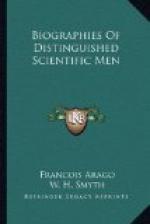Herschel increased the catalogue, already so extensive, of the mysteries of vision, when he explained in what manner we must endeavour to distinguish separately the two members of certain double stars very close to each other. He said if you wish to assure yourself that e Coronae is a double star, first direct your telescope to a Geminorum, to z Aquarii, to m Draconis, to r Herculis, to a Piscium, to e Lyrae. Look at those stars for a long time, so as to acquire the habit of observing such objects. Then pass on to x Ursae majoris, where the closeness of the two members is still greater. In a third essay select i Bootis (marked 44 by Flamsteed and i in Harris’s maps)[21], the star that precedes a Orionis, n of the same constellation, and you will then be prepared for the more difficult observation of e Coronae. Indeed e Coronae is a sort of miniature of i Bootis, which may itself be considered as a miniature of a Gem. (Philosophical Transactions, 1782, p. 100.)
As soon as Piazzi, Olbers, and Harding had discovered three of the numerous telescopic planets now known, Herschel proposed to himself to determine their real magnitudes; but telescopes not having then been applied to the measurement of excessively small angles, it became requisite, in order to avoid any illusion, to try some experiments adapted to giving a scale of the powers of those instruments. Such was the labour of that indefatigable astronomer, of which I am going to give a compressed abridgment.
The author relates first, that in 1774, he endeavoured to ascertain experimentally, with the naked eye and at the distance of distinct vision, what angle a circle must subtend to be distinguished by its form from a square of similar dimensions. The angle was never smaller than 2’ 17”; therefore at its maximum it was about one fourteenth of the angle subtended by the diameter of the moon.
Herschel did not say, either of what nature the circles and squares of paper were that he used, nor on what background they were projected. It is a lacuna to be regretted, for in those phenomena the intensity of light must be an important feature. However it may have been, the scrupulous observer not daring to extend to telescopic vision what he had discovered relative to vision with the naked eye, he undertook to do away with all doubt, by direct observations.
On examining some pins’ heads placed at a distance in the open air, with a three-foot telescope, Herschel could easily discern that those bodies were round, when the subtended angles became, after their enlargement, 2’ 19”. This is almost exactly the result obtained with the naked eye.
When the globules were darker; when, instead of pins’ heads, small globules of sealing-wax were used, their spherical form did not begin to be distinctly visible till the moment when the subtended magnified angles, that is, the moment when the natural angle multiplied by the magnifying power, amounted to five minutes.




